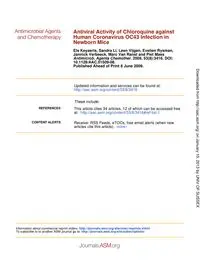
2009 Antiviral Activity of Chloroquine against Human Coronavirus OC43 Infection in Newborn Mice PDF
Preview 2009 Antiviral Activity of Chloroquine against Human Coronavirus OC43 Infection in Newborn Mice
Published Ahead of Print 8 June 2009. 10.1128/AAC.01509-08. 2009, 53(8):3416. DOI: Antimicrob. Agents Chemother. Jannick Verbeeck, Marc Van Ranst and Piet Maes Els Keyaerts, Sandra Li, Leen Vijgen, Evelien Rysman, Newborn Mice Human Coronavirus OC43 Infection in Antiviral Activity of Chloroquine against http://aac.asm.org/content/53/8/3416 Updated information and services can be found at: These include: REFERENCES http://aac.asm.org/content/53/8/3416#ref-list-1 at: This article cites 34 articles, 12 of which can be accessed free CONTENT ALERTS more» articles cite this article), Receive: RSS Feeds, eTOCs, free email alerts (when new http://journals.asm.org/site/misc/reprints.xhtml Information about commercial reprint orders: http://journals.asm.org/site/subscriptions/ To subscribe to to another ASM Journal go to: on January 10, 2013 by UNIV OF SUSSEX http://aac.asm.org/ Downloaded from ANTIMICROBIAL AGENTS AND CHEMOTHERAPY, Aug. 2009, p. 3416–3421 Vol. 53, No. 8 0066-4804/09/$08.00�0 doi:10.1128/AAC.01509-08 Copyright © 2009, American Society for Microbiology. All Rights Reserved. Antiviral Activity of Chloroquine against Human Coronavirus OC43 Infection in Newborn Mice� Els Keyaerts, Sandra Li, Leen Vijgen, Evelien Rysman, Jannick Verbeeck, Marc Van Ranst,* and Piet Maes Laboratory of Clinical Virology, Department of Microbiology and Immunology, Rega Institute for Medical Research, University of Leuven, Leuven, Belgium Received 12 November 2008/Returned for modification 24 December 2008/Accepted 9 April 2009 Until recently, human coronaviruses (HCoVs), such as HCoV strain OC43 (HCoV-OC43), were mainly known to cause 15 to 30% of mild upper respiratory tract infections. In recent years, the identification of new HCoVs, including severe acute respiratory syndrome coronavirus, revealed that HCoVs can be highly patho- genic and can cause more severe upper and lower respiratory tract infections, including bronchiolitis and pneumonia. To date, no specific antiviral drugs to prevent or treat HCoV infections are available. We demonstrate that chloroquine, a widely used drug with well-known antimalarial effects, inhibits HCoV-OC43 replication in HRT-18 cells, with a 50% effective concentration (� standard deviation) of 0.306 � 0.0091 �M and a 50% cytotoxic concentration (� standard deviation) of 419 � 192.5 �M, resulting in a selectivity index of 1,369. Further, we investigated whether chloroquine could prevent HCoV-OC43-induced death in newborn mice. Our results show that a lethal HCoV-OC43 infection in newborn C57BL/6 mice can be treated with chloroquine acquired transplacentally or via maternal milk. The highest survival rate (98.6%) of the pups was found when mother mice were treated daily with a concentration of 15 mg of chloroquine per kg of body weight. Survival rates declined in a dose-dependent manner, with 88% survival when treated with 5 mg/kg chloroquine and 13% survival when treated with 1 mg/kg chloroquine. Our results show that chloroquine can be highly effective against HCoV-OC43 infection in newborn mice and may be considered as a future drug against HCoVs. Coronaviruses are large, enveloped, single-stranded, posi- tive-sense RNA viruses with a genome of approximately 30 kb in length, the largest found in any of the RNA viruses. The genus Coronavirus belongs to the family Coronaviridae in the order Nidovirales. The coronaviruses are classified into three groups based on genetic and serological relationships. Group 1 contains porcine epidemic diarrhea virus, porcine transmissi- ble gastroenteritis virus, canine coronavirus, feline infectious peritonitis virus, human coronavirus 229E (HCoV-229E), and HCoV-NL63. Group 2 contains murine hepatitis virus, bovine coronavirus (BCoV), HCoV-OC43, rat sialodacryoadenitis virus, porcine hemagglutinating encephalomyelitis virus (PHEV), ca- nine respiratory coronavirus, and equine coronavirus. The se- vere acute respiratory syndrome coronavirus (SARS-CoV) is considered a distant member of group 2 and is therefore placed in a subgroup, 2b (13). Group 3 thus far contains only avian coronaviruses, such as infectious bronchitis virus and turkey coronavirus. Within group 2, HCoV-OC43 is most closely genetic related to BCoV (33). A comparative analysis of the complete genomes of HCoV-OC43, BCoV, and PHEV demonstrated a high genetic similarity among these three coro- naviruses in more than two-thirds of their genomes, except in the hemagglutinin-esterase and spike gene region, in which PHEV was remarkably divergent from HCoV-OC43 and BCoV (30, 31, 33). HCoVs cause respiratory infections, but gastroenteritis and neurological disorders can also occur (3, 20). Until now, five HCoVs have been described. HCoV-OC43 and HCoV-229E are responsible for 10 to 30% of all common colds, and infec- tions occur mainly during the winter and early spring (21). In 2003, a novel HCoV displaying only distant antigenic and ge- netic similarities to the two previously known HCoVs was identified as the causal agent of SARS, and this causes severe lung disorder, leading in some cases to systemic infection and eventually death in about 10% of cases (19). During the two years after the SARS outbreak, two additional previously un- recognized coronaviruses affecting humans, HCoV-NL63 and HCoV-HKU1, were identified (29, 35). HCoV-NL63 infection is related to acute respiratory dysfunction in infected individ- uals. Furthermore, HCoV-NL63 was identified as the major pathogen responsible for croup in young children (9, 10, 22). The clinical features of HCoV-NL63 infections appear to be more severe than those commonly attributed to infections by HCoV-OC43 and HCoV-229E (4, 12, 29). Infection with HCoV-HKU1 is mostly associated with bronchiolitis and pneu- monia (35, 36). Although coronaviruses have been recognized as human pathogens for about 50 years, no effective treatment strategy has been approved. This shortcoming became evident during the SARS-CoV outbreak and was the start of numerous stud- ies. Nevertheless, 5 years after the outbreak, we are still lacking an effective commercially available drug. Chloroquine is a clin- ically approved drug effective against malaria, and it is known * Corresponding author. Mailing address: Laboratory of Clinical Virology, Department of Microbiology and Immunology, Rega Insti- tute for Medical Research, University of Leuven, Minderbroede- rsstraat 10, B3000 Leuven, Belgium. Phone: 32-16-347908. Fax: 32-16- 347900. E-mail:
